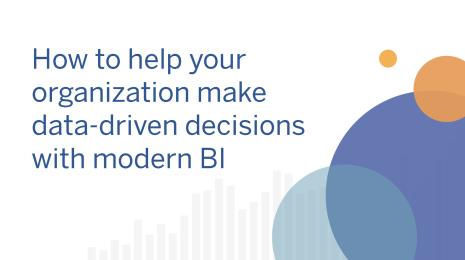Culture of analytics: Good for people, essential for business

Editor's note: This piece first appeared in VentureBeat.
None of us like being in the dark. That’s because our curiosity is innate. We all want to know what’s what. As researcher Jonathan Litman put it, we find knowledge rewarding because it “dispels undesirable states of ignorance and uncertainty."
But we’re never satisfied knowing just what things are; we also need to know why something is, how it came to be. We don’t simply want the answer; we want to be a part of the discovery process. What we learn along the way helps us avoid the bad, replicate the good, and find new opportunities.
As we try to gain understanding and find those answers, we have data to help. And that’s where a culture of analytics comes in.
What a culture of analytics looks like
This culture leverages an organization’s two greatest assets, its people and its data. The organization provides an environment in which employees can find answers in their data, satisfying their curiosity and driving the business forward.
By allowing employees to explore data within a trusted and secure environment, organizations empower the person who knows the business, has the context, and can realize the full potential of the insights. The person can investigate and collaborate on the data, and make smart decisions as a result of that analysis.
This ability to see and understand data isn’t tied to job titles. In this culture, everyone has access to the right data and is encouraged to explore. Anyone can uncover actionable insights, share findings, and improve outcomes.
The benefits of a culture of analytics
Many organizations have already adopted this approach to great effect. At Seattle Children's Hospital, a data-driven culture has led to shorter wait times and better patient care.
“In the past, we spent days, sometimes weeks developing something as simple as a patient volume-based dashboard. We’ve converted that to monthly dashboards and are looking at daily dashboards to improve day-to-day decision-making," says Jason Jio, the hospital’s administrative director of surgical services.
The "we" in this situation refers to teams across the organization. Analysts, managers, clinicians, doctors, and researchers all use data analytics to uncover insights, track progress, and optimize results. This group effort has proven crucial to helping Seattle Children's understand the why behind patient trends.
“We were able to set up a fantastic visualization that showed some of the root causes and contributing factors for patient waiting," Jio said.
Collaboration is another crucial piece of this culture. People can quickly and easily share their data and their analysis. They can build on each other’s findings to perform their own analysis and ask follow-up questions.
Deloitte calls this a “culture of enablement.” At the professional-services firm, staff-level employees drive data analytics, finding and sharing insights with the rest of the team. The leadership empowers them with the right tools to spot opportunities quickly and easily. And IT supports the entire program by providing governance and security.
“People can more quickly get to the ‘so what’ or the ‘aha.’ They're more willing and ready to share analysis faster than what's typically been expected,” said Ryan Renner, strategy and operations principal at Deloitte. “And when they have that excitement and that enthusiasm, it actually goes up through our organization and we hear very positive feedback from our leaders.”
The pillars of an analytical culture
From LinkedIn to AerLingus, to Ancestry.com, there are many more companies who’ve embraced this this culture and maximized the impact of their data. But building a culture isn’t something that happens overnight or can be adopted out of the box. It requires continued focus and purposeful decision-making over time.
One key component is executive sponsorship for the analytics initiative. A McKinsey Global Survey found that organizations with high-performing analytics programs are nearly three times more likely than their low-performing peers to have CEO sponsorship for their analytics program.
An executive sponsor can help guide change with an enterprise perspective. This leader might ask: How can we empower anyone to ask questions? Do they have the right tools for the job? Are people heard when they share their discoveries, and are they encouraged to do so?
A sponsor can help set the right organizational structure to support the initiative and incentivize participation. The sponsor can also share findings and elevate conversations by asking which data compelled a certain conclusion. These examples signal to others that they, too, should leverage the value of their data.
The second and equally crucial part of empowerment comes from IT. With modern enterprise analytics platforms, organizations no longer have to sacrifice governance for self-service, or vice versa. Instead, a new type of relationship forms between IT and the business with the focus on achieving a common end goal.
IT creates a centralized environment of trusted data and content. Then IT enables the business to access this data, investigate the data, and find answers in real-time. Security and data integrity don’t come at the expense of business agility and innovation.
This approach signals a paradigm shift in the role of IT. For modern IT organizations, success is more than just finishing projects on time and on budget. IT should also ask itself: Are people actually using the systems we put into place? Is adoption high? And are we helping the business innovate and grow?
By enabling a governed approach to self-service analytics, IT helps maximize the impact of data and becomes a strategic partner to the business.
Good for people, essential for the business
A culture of analytics benefits both the business and the individual. Empowering individuals to explore data also helps them connect to a purpose larger than themselves. Being able to provide great customer service or effecting positive change in the world are examples of purpose-aligned work. It’s extremely rewarding to know how the organization is tracking toward its purpose and be able to impact that progress.
Seeing a premade chart during the last mile of a project doesn’t produce the same emotional engagement. Intrinsic reward comes from using data throughout the process to make educated decisions and measure progress along the way. This satisfies our curiosity and our need to understand.
And that’s good news for the organization as well. Engagement not only helps make for happier teams but also makes for more productive people and, ultimately, a better bottom line.
To start building an analytical culture at your organization, check out our whitepaper, How to build a culture of self-service analytics—and why you should.
Storie correlate
Subscribe to our blog
Ricevi via e-mail gli aggiornamenti di Tableau.








